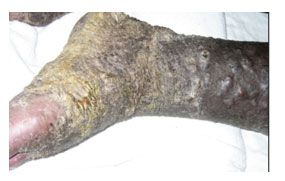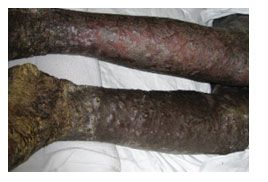- Clinical Technology
- Adult Immunization
- Hepatology
- Pediatric Immunization
- Screening
- Psychiatry
- Allergy
- Women's Health
- Cardiology
- Pediatrics
- Dermatology
- Endocrinology
- Pain Management
- Gastroenterology
- Infectious Disease
- Obesity Medicine
- Rheumatology
- Nephrology
- Neurology
- Pulmonology
Elephantiasis Nostras Verrucosa Secondary to Kaposi Sarcoma: A Rare Case
A 52-year-old woman presented with a 2-year history of progressive bilateral lower extremity edema and increasing pain. The patient complained of shortness of breath, productive cough, and rash on the upper extremities and torso for the past year.
A 52-year-old woman presented with a 2-year history of progressive bilateral lower extremity edema and increasing pain. The patient complained of shortness of breath, productive cough, and rash on the upper extremities and torso for the past year. The patient was afebrile with stable vital signs. She had violet plaques on her upper extremities and torso. She also had severe woody edema with verrucous changes on her bilateral lower extremities (Figures 1 and 2). She was anemic, with a hemoglobin level of 9 g/dL. Results of rapid testing for HIV antibody were positive.

Figure 1. Left foot with severe woody edema, verrucous changes, severe lichenification, and nodularity.

Figure 2. Chronic edema of the lower extremities with thickening, hyperpigmentation, and ulcerative nodules.
The patient was seen by a dermatologist who diagnosed the violet lesions as Kaposi sarcoma (KS). A skin biopsy was performed, and pathological testing confirmed KS with positive human herpesvirus 8 (HHV8) immunostaining using latent nuclear antigen-1, a monoclonal antibody that stains nuclear material in HHV8-infected lesional cells in KS plaques.
CT scans of the chest, abdomen, pelvis, and lower extremities demonstrated lymphadenopathy along the external iliac chains bilaterally, shotty lymph nodes along the retroperitoneum, and anasarca in the abdomen. The common femoral veins and arteries were surrounded by enhancing infiltrative changes. A CT scan of the chest demonstrated peribronchovascular nodular opacities diffusely within the lungs. Based on the skin findings, the radiological abnormalities were believed to represent visceral KS causing lymphatic obstruction. The findings of a dermatological evaluation of the patient’s lower extremities were consistent with elephantiasis nostras verrucosa. Findings on examination of a skin scraping using a mineral oil preparation ruled out Norwegian scabies.
The patient’s hospital course included a bronchoscopy, which demonstrated scattered erythematous endobronchial lesions consistent with KS. The results of upper endoscopy and colonoscopy performed as part of a workup for anemia, which demonstrated erythematous masses in the esophagus, stomach, and duodenum, were consistent with KS. The patient’s CD4+ cell count was 374/µL (13.8%), and her HIV branched DNA level was 59,561 copies/mL. Results of testing for hepatitis B surface antigen were negative, but results were positive for hepatitis C virus antibody. Rapid plasma reagin was positive at a titer of 1:512.
Three intramuscular injections of penicillin G benzathine were administered for treatment of late latent syphilis. In addition, the patient was started on a regimen of tenofovir, emtricitabine, and ritonavir-boosted atazanavir. The KS was treated with liposomal doxorubicin, and her swollen lower extremities were treated with diuretics, topical amlactin, and leg elevation. She was discharged to an inpatient hospice facility. Currently, she has completed 8 cycles of liposomal doxorubicin, with improvement in both the pulmonary and skin lesions.
Elephantiasis nostras verrucosa represents a group of cutaneous changes comprising dermal fibrosis and hyperkeratotic, verrucous, and papillomatous lesions after chronic secondary nonfilarial lymphedema caused by blockage of the lymphatic system.1,2 A number of cases have been reported in the literature describing AIDS-related hyperkeratotic KS with associated severe lymphedema.3-5 This report illustrates a case of AIDS-related KS with widespread organ involvement that led to chronic lymphedema secondary to tumor lymphatic obstruction and resulted in a dramatic representation of elephantiasis nostras verrucosa.
Elephantiasis nostras verrucosa occurs secondary to persistent lymphedema. Classically, the term “elephantiasis” had been used to indicate the cutaneous changes caused by Wuchereria bancrofti infestation. In 1934, Castellani and colleagues6 added the word “nostras” to separate this tropical type from the lymphedematous disorders of temperate regions not caused by filariasis. Numerous conditions have been implicated, including congenital, traumatic, or surgical disruption of the lymphatics; venous stasis; radiation; neoplastic obstruction; portal hypertension; obesity; and congestive heart failure. There have been reports of more rare associations, such as Graves disease–induced pretibial myxedema presenting as elephantiasis nostras verrucosa.7
Because of lymphostasis, there is an accumulation of protein and cellular metabolites that lead to accumulation of water and an increase in the volume of the extremity.8 This accumulation stimulates fibrogenesis and is associated with inflammatory changes. Clinically, this manifests as profound, nonpitting edema that is firm and brawny with woody fibrosis and numerous verrucoid lesions giving it a cobblestone-like appearance. Skin biopsy usually reveals pseudoepitheliomatous hyperplasia with dilated lymphatic spaces, chronic inflammation with fibroblast proliferation, collagen destruction, and loss of sweat glands. As the condition progresses, the patient is prone to frequent bouts of cellulitis, leading to further worsening of skin changes.2
Therapy includes elevation and compression of the extremity. Local wound care with topical retinoids, which reduce epidermal proliferation, collagen synthesis, and inflammation, has been useful. Diuretics may also be used. Alleviation of lymphatic obstruction is paramount. Rarely, surgical approaches are indicated in cases that are nonresponsive to medical therapy.9 In cases of recurrent cellulitis, long-term prophylactic use of antibiotics may be helpful.10 Early and timely intervention is best to avoid extreme measures, such as amputation of the limb.
No potential conflict of interest relevant to this article was reported by the authors.
References:
References1. Bhandari M, Kempin S, Aziz MS. AIDS-related osseous Kaposi sarcoma. AIDS Reader. 2007;17:202-203.
2. Vaccaro M, Borgia F, Guarneri F, Cannavó SP. Elephantiasis nostras verrucosa. Int J Dermatol. 2000;39:764-766.
3. Hengge UR, Stocks K, Goos M. Acquired immune deficiency syndrome-related hyperkeratotic Kaposi’s sarcoma with severe lymphoedema: report of five cases. Br J Dermatol. 2000;142:501-505.
4. Allen P, Gillespie DL, Redfield RR, Gomez ER. Lower extremity lymphedema caused by acquired immune deficiency syndrome-related Kaposi’s sarcoma: case report and review of the literature. J Vasc Surg. 1995;22:178-181.
5. Harbit M, Srinivas PB. Kaposi’s sarcoma with elephantiasis associated with AIDS. J Wound Ostomy Continence Nurs. 1995;22:223-226.
6. Castellani A. Elephantiasis nostras. J Trop Med Hyg. 1934;37:257-264.
7. Kakati S, Doley B, Pal S, Deka UJ. Elephantiasis nostras verrucosa: a rare thyroid dermopathy in Graves’ disease. J Assoc Physicians India. 2005;53:571-572.
8. Yoho R, Budny AM, Pea AS. Elephantiasis nostras verrucosa. J Am Podiatr Med Assoc. 2006;96:442-444.
9. Iwao F, Sato-Masumura KC, Sawamura D, Shimizu H. Elephantiasis nostras verrucosa successfully treated by surgical debridement. Dermatol Surg. 2004; 30:939-941.
10. Pherez FM, Sandkovsky G, Chaudhari S. Elephantiasis nostras verrucosa. Consultant. 2007;47:493.
